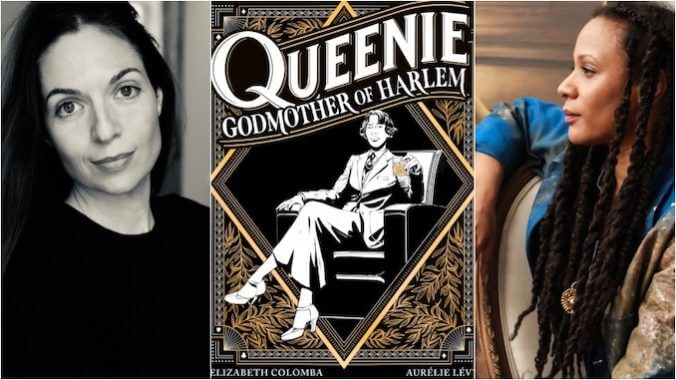Graphic Novel Queenie Distills the Life Story of Infamous Gangster Stephanie St. Clair, Godmother of Harlem
Books Features Graphic Novels
By most measures, Stephanie St. Clair lived an extraordinary life. Known as the Queen of Harlem, the Queen of Numbers, Madame Queen, and simply, Queenie, she was tough as nails, savvy, viscous, and supremely intelligent. Born into plantation life in Martinique, she survived a traumatic childhood and escaped to France as a teen. A few years later, St. Clair arrived in America and rose to power in New York, becoming one of the most successful gangsters to come out of the 20th century. Despite that, St. Clair’s story has been mostly brushed over in comparison to her contemporaries like Lucky Luciano, Ellsworth ‘Bumpy’ Johnson and Dutch Schultz.
Queenie: Godmother of Harlem, a new graphic novel by acclaimed artist Elizabeth Colomba and screenwriter Aurelie Levy is looking to change that. Set to release on Jan. 17 via Abrams Books, Queenie is an enthralling look at St. Clair’s rise and rule during the Harlem Renaissance. While details are scarce about her youth, St. Clair spoke fluent French and English as well as Spanish and was one of many African Americans that joined the Great Migration in the early 1900s. As Harlem flourished around her with the new music, art, and literary scene, St. Clair built up a numbers racket akin to the modern lottery, which netted around $100,000 for Queenie at its height. Comparatively, in 1930 the average person was making $1,550 a year, a month of rent cost around $50 and even the President of the United States was only making a salary of $75,000.
Colomba, whose mother is from Martinique, told Paste she first heard about St. Clair a few years ago, sparking the inspiration for the book. Traditionally a painter, Colomba said she instinctively reached for her brushes and canvas after hearing Queenie’s tale, but as she researched further, the more she wanted to share St. Clair’s full story. It wasn’t until Colomba saw a Kerry James Marshall retrospective at the Met Breuer by ??The Metropolitan Museum of Art that the idea to create a comic book started to form.
“It was always important to her that both my sister and I were aware of and knowledgeable about persons that populated our history—whether intellectual figures like Cesaire, Fanon, or Zobel, or like Stephanie: a woman who chose to play her cards altogether differently,” she said. “I drew five pages and talked to Aurelie about Stephanie St Clair and the idea of a graphic
novel. She introduced me to her editor Stephen Carriere who fell in love with the project instantly.”
St. Clair’s life story is as messy as it is massive, so Colomba and Levy said they found ways to sprinkle useful information throughout the book while keeping playful. In order to celebrate this larger-than-life character and avoid the pitfalls of the biopic, Levy said they strove to craft a story that would be both riveting and entertaining, despite the seriousness of the subject and the times. In the end, they opted to mix biographical elements with fictional ones.
“Fascinatingly, one of my collectors found out that fifteen-year-old Ella Fitzgerald in fact worked as a runner for the illegal numbers game,” Colomba said. “While too late for us to incorporate it in the script, it’s a wonderful nugget, and one which I’d never have gleaned if it weren’t for Stephanie.”
As the banker and head of the numbers operation, St. Clair, along with her right-hand man, Ellsworth ‘Bumpy’ Johnson ran a large workforce including runners, who collected slips and paid winners, comptrollers and security. Queenie was a fiery businesswoman, but she quickly became a folk hero for Black Harlemites, providing financial support to many Black businesses, advocating for racial advancement, and calling out police corruption. St. Clair demonstrated an uncanny knowledge of the power of media by taking out ads in local newspapers decrying community injustices, and providing PSA-like announcements for Harlem residents while polishing her image.
Throughout her life, St. Clair had to fight tooth and nail for everything she got, but it all came to a head in the years after Prohibition. The mafia was growing in New York under the leadership of the Commission and Lucky Luciano and after a stint in jail, St. Clair was facing a power struggle to maintain her empire. In addition, she had to contend with a notoriously corrupt police force and vicious gangster Dutch Shultz who was intent on taking the business from her by way of force. Queenie begins with St. Clair’s release from prison in 1933, as she faces an uphill battle to retain her empire.
“Truth depends on perspective and is often layered. Our graphic novel is composed of many sources, some of which even contradict or challenge each other in small ways, as with Stephanie’s birth date,” Colomba said. “We do not claim to have captured everything. Rather, we believe that what we have captured, holds true not so starkly as fact but as true to the character and significance of Stephanie St. Clair, and most notably, to her legacy.”
Dana Forsythe is based in Boston and is a longtime reporter covering art, comic books and culture.